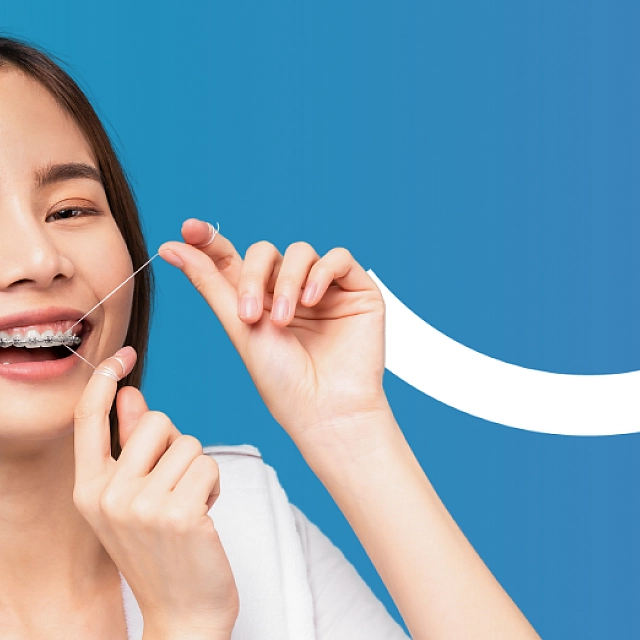
What are Orthodontic Elastics?
Orthodontic elastics are small rubber bands made of either latex, or non latex material that are used in both braces and Invisalign treatment. You will be responsible to place the elastics on your braces or Invisalign and in most cases change them several times per day. They apply gentle continuous force to the teeth, and the way the elastics are placed determines how the teeth or bite will change.
Orthodontics is not just about straightening teeth, but improving your bite, or how your top and bottom teeth fit together. Elastics generally are what corrects bite issues, providing you with a lifetime of efficient chewing that will maintain healthy bone and gums. Aligning the bite is the final goal of orthodontic treatment after the teeth are straightened.
How Orthodontic Elastics Work
The elastics apply a light, continuous force on the teeth to help guide the teeth and bite into the correct position. The force needs to be applied consistently in order to be effective, so it is very important to follow your Orthodontist’s instructions on how many hours per day you have the elastics on, and how often you change them.
The pressure created by the elastics moves the teeth in the same way that the braces or Invisalign aligners do - by stimulating bone remodeling and allowing the teeth to move into the remodeled area. The specific way your elastics are attached dictates the direction of the force and therefore movement.
Types of Elastics and Placement Patterns
Orthodontic elastics can vary by size (diameter of the rubber band) and strength (thickness of the rubber band) as the distance between the attachment points, and the force needed for certain movements varies. Elastics are worn in different patterns depending on the desired movement. While there are many different combinations of elastics, we will review some of the common ones.
Class 2 Elastics
This pattern typically runs an elastic band from the upper canine area to a lower molar to correct overjet, where the top teeth are too far forward compared to the bottom teeth. This animation shows Class 2 elastic bands for braces.
Class 3 Elastics
This pattern typically runs an elastic band from the lower canine area to an upper molar to correct an underbite, where the bottom teeth are too far forward compared to the top teeth. This animation demonstrates Class 3 elastic bands for braces.
Triangle or box Elastics
These are typically rubber bands run between upper and lower teeth in a triangular shape, or in a small box and are used to tighten up the bite in a specific area. This animation demonstrates triangle elastic bands for braces.
Midline Elastics
This pattern typically runs a rubber band from an upper canine to the lower canine on the opposite side, and corrects the midline discrepancy, which is where the middle of the top teeth does not line up with the middle of the bottom teeth. This animation demonstrates Midline elastics on braces.
Crossbite elastics
This pattern typically runs a rubber band from the inside of a top tooth, to the outside of a bottom tooth and is used to correct a crossbite. A crossbite is when one or more upper teeth bite on the inside of the bottom teeth, rather than on the outside as they normally would. This animation demonstrates Crossbite elastics for braces.
Why Consistent Elastic Wear is Crucial to Achieving a Healthy Bite
Elastics are often prescribed to be worn for 20-24 hours per day which allows for the force on the teeth to be consistent. Lack of consistent elastic wear can lead to poor tooth movement, delayed treatment time and more soreness in your teeth.
Your Orthodontist has a very specific goal for your bite, and consistent elastic wear is often the ONLY way to achieve this. Elastics provide the fine-tuning force needed for the exact positioning required for an ideal bite.
Consequences of Not Wearing Elastics
The teeth are only able to remodel bone and move when the elastics are on your braces or aligners. If you wear the elastics all night while you are sleeping, but do not wear them during the day, the progress you made during the night can be lost during the day.
The bite correction takes much longer this way, stopping or even reversing progress and can mean that your braces or aligners may stay on longer than anticipated. Inconsistent elastic wear is one of the most common reasons orthodontic treatment takes longer than initially planned.
Without proper elastic wear, you may have to accept a compromised final result of your treatment. The bite correction may not be complete, and will likely not be as stable because of the lack of compliance. This can lead to issues with chewing, jaw pain, or excessive wear on certain teeth over time.
It is extremely important to follow your Orthodontist's specific instructions regarding which teeth to attach the elastics to, how many hours a day to wear the elastics, and how often to put on a new pair of rubber bands.
Practical Tips for Wearing Elastics
Your Orthodontist will most likely recommend that you wear your elastics all day and night, and change them a few times per day. Here are some tips to help you develop good habits with your elastics.
Remove your current elastics and replace them with new ones, in the same pattern 3-4 times per day, or as instructed
The rubber bands will be stretched out and lose their strength over time, which is why it is recommended to change them frequently to maintain the pressure
Always carry a package of elastics with you in case one breaks or you need to change them
Before you take your elastics off for the first time, take a picture of them on so you remember how to put the new ones on
Your teeth will be sore for a few days while you adjust to the elastics, however if you wear them consistently they will get used to it
Inconsistent elastic wear means your teeth will be sore every time you wear them
Remove your elastics for eating and brushing, unless specifically instructed - this is an ideal time to change your elastics
If you are running low on elastics, call us! You can stop by to get more, or we can mail some to you
If you find that you are forgetting to wear your elastics, or to change them, try setting a reminder or alarm on your phone
Debunking Elastic Myths
“They only work at night”
Elastics are most effective when worn all day and night for continuous force on the teeth.
“Skipping a day or two is fine”
Not wearing elastics consistently - all day and night, every day - can slow or stop progress. You can lose progress on skipped days - 2 steps forward, 1 step back.
“Wearing more elastics makes them work faster”
Doubling up on elastics, or wearing more than you are instructed to can do more harm than good. Wearing extra elastics can apply excessive force on the teeth which can damage the teeth, roots, bone and could cause untended movement to occur, delaying your treatment time.
“If they don’t hurt, they aren’t working”
Some initial discomfort is expected when you first start wearing elastics, or change the pattern you are wearing them in. Once your teeth adjust to the pressure, they will continue to move but without the pain.
“My teeth are straight, I don’t need to wear elastics”
Elastics primarily correct the bite (how the top and bottom teeth fit together), which is a very important part of orthodontic treatment.
The 'Elastic Journey' - Patient Persistence Pays Off
Wearing elastics can be inconvenient and challenging at times, but it is a temporary, but very important phase of your treatment. If you persevere and wear your elastics as instructed, you will be rewarded with a stable, healthy, efficient bite now, and in the future.
Having trouble staying motivated to wear your elastics?
Focus on the end goal - getting your braces or aligners off
Remind yourself you are in the final stages of treatment
Remember that when your treatment ends is partially in your control
Connect with your peers who have worn elastics
Conclusion: Finishing Strong for Your Best Smile
One of the most important aspects of orthodontics is to correct malocclusion, or bite issues. The best and most effective way of doing this is by wearing elastics. For this phase of treatment to be successful, consistent elastic wear is critical.
You have control over your tooth movement during this time, and how soon your braces come off, or aligners are finished is partly up to you now! The better you wear your elastics, the sooner your treatment will be finished.
Find out more about elastics from the American Association of Orthodontists here https://aaoinfo.org/treatments/orthodontic-elastics/
Elastic FAQs
“How long will I have to wear elastics?”
This will vary depending on your bite correction needs, or how much your teeth need to move. You can typically expect a few months to a year of wearing elastic bands.
“Do elastics hurt?”
You may experience some initial discomfort or soreness for a few days, similar to getting a new wire put in your braces, or starting a new aligner. If you wear them consistently this should only last for a few days
“Can I eat with elastics on?”
Generally it is recommended to remove the elastics while you eat, to make chewing easier and to eliminate the chance of accidentally swallowing a rubber band.
“How do elastics affect speaking?”
Some patients notice a slight lisp or difficulty speaking initially, as your top and bottom teeth may feel like they are being pulled together. Any speech issues with elastics tend to be very minor, and improve quickly with practice.
“What if I forget to wear them for a few hours?”
Try and put them back on as soon as you remember and get back into your routine. Never skip a whole day.
“What if I lose my elastics?”
Call our office right away to get more elastics, do not wait until your next appointment.
“My elastic broke as soon as I put it in.”
This can sometimes happen. Simply throw it out and put on a fresh rubber band.
“My Orthodontist gave me a diagram on where to put my elastics, but I am still confused.”
Call the office and ask for clarification on where to put the elastics, or schedule a virtual or in person quick visit to review. Tip - take a picture of your elastics at the office so you remember how to put them on




